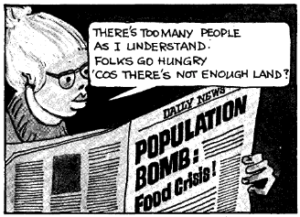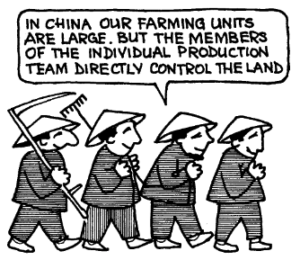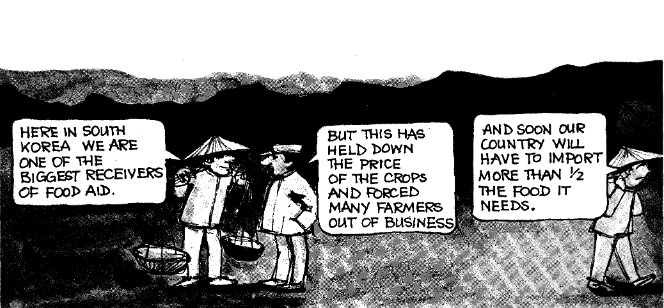This essay is reproduced here as it appeared in the print edition of the original Science for the People magazine. These web-formatted archives are preserved complete with typographical errors and available for reference and educational and activist use. Scanned PDFs of the back issues can be browsed by headline at the website for the 2014 SftP conference held at UMass-Amherst. For more information or to support the project, email sftp.publishing@gmail.com
So Much for the Myths of Hunger
by Barbara Chasin, Connie Phillips, Sue Tafler, & Betsy Walker
‘Science for the People’ Vol. 9, No. 6, November-December 1977, p. 25–29
Except perhaps for nuclear war, nothing in our times so threatens a majority of the world’s people as do hunger and starvation. The prospects for a reasonably nutritional diet seem increasingly dim for hundreds of millions. Newspaper items predicting mass famine, accompanied by photographs of deformed, starving Asian and African children, have become commonplace. Even in the United States, evidence is accumulating that hard times may be here for millions who want to eat.
The food problem has become a recurring media topic. TV Guide and the newspapers ran full page ads for an “extraordinary human drama.” From 1-5 p.m. July 31, 1977, you could “journey to Asia, Africa, and Latin America for intimate revealing visits with hungry families … feel the agony of hopeless mothers and fathers who watch their little ones growing up with crippled minds and bodies due to malnutrition.” For four hours the viewer was confronted with images of starving people while messages, some in the form of song, told the hungry world to “hang on … help is finally on the way.” In patronizing, condescending tones, implying that the hungry of the world could not manage without our help, Billy Graham, Art Linkletter, Carol Lawrence, Vincent Price, Julie Andrews, Steve Allen and others urged, uninterrupted by commercial messages, that we be compassionate and Christian. A donation of only $10.00 could mean the difference between life and death for one person. Our individual caring could quiet the “cry of a hurting world.”
This show provides a particularly dramatic example of the propaganda that is being disseminated around the food issue. The most common cause of hunger is alleged to be overpopulation. The speakers on the TV marathon offered a somewhat sophisticated approach to the population explosion, mentioning, for example, that people have children because they need them for labor, or security in old age. Nevertheless, the speakers concluded that the solution is to set up family planning clinics.
Overpopulation is probably the most frequent explanation the “experts” from governmental agencies and private foundations have for the food crisis. There are simply too many people and not enough land and food to go around. Other contributing factors are the vagaries of weather and climate (short—and long-term fluctuations), the backwardness of the peasants—their lack of both modern agricultural techniques and an entrepreneurial mentality—and the greediness of United States citizens.
These same “experts” put forth a range of possible solutions. Family planning is the most common. Food banks have also been suggested, so that when times are bad the hungry nations can draw upon the deposited reserves. New sources of food and fertilizer are being researched, such as the possibilities of using kelp and of developing single-cell protein-rich microorganisms. Solar energy and rational recycling are urged by some groups as ways to conserve resources in order to help provide more food. On a more individualistic basis, the allegedly well-fed U.S. citizens are urged to give up eating so much meat, to care more about the world and stop hogging valuable resources. Finally, there are those who advocate that we let the teeming multitudes die off so that the balance between food and people can be restored.
While this last harsh approach, sometimes referred to as “triage”1 or “lifeboat ethics,”2 can be easily criticized, some of the other suggestions make a certain amount of sense. However, no solution, no matter how plausible it sounds, will work unless the real causes of hunger are addressed. Writings which provide a valid analysis of the roots of world hunger are few. Two excellent studies have just been published which go a long way in providing the kind of data needed for reasoned action. These are Food First: Beyond the Myth of Scarcity by Frances Moore Lappe, Joseph Collins, and Cary Fowler (1) and How the Other Half Dies by Susan George.(2) The authors of these books were involved in producing counterreports for the United Nations-sponsored World Food Conference held in Rome in 1974. These books explicitly refute the conventional myths of the food crisis and present convincing alternatives to all of the views described above. Hunger, as these authors analyze it, is caused by unequal distribution of wealth and power, an inevitable by-product of capitalism.
Too Many People?
Too many people is a problem, but it is not the cause of hunger. Current rates of growth will undercut the future well-being of all of us. But hunger and high birth rates are both symptoms of the same disease: “the insecurity and poverty of the majority that result when a minority controls a country’s productive resources.” (Lappe et al., p. 64.) China, which constitutes one-fifth of the world’s population, provides an important counterexample to the “overpopulation” theory. In China, where people’s economic security is assured, the rate of reproduction has changed impressively. Within a five year period, between 1970 and 1975, China’s birth rate dropped from 32 per 1000 to between 20 and 25 per 1000 (Lappe et al., p. 67). The illusion of overpopulation only appears when a country’s resources are controlled by a powerful few, who don’t distribute them equally among the population. As long as more and more people are severed from control over and participation in the productive and distributive process, we will have the problem of too many people.
Not Enough Land and Food?
There is no scarcity of land. The scarcity of food is caused by those who own land but do not use it to grow food. As long as the majority of the earth’s people are at the mercy of food and land manipulation by the few, hunger, famine and starvation will continue. The authors examine some facts: Less than 45% of the world’s potentially arable land is cultivated (Lappe et al., p. 16). Much of this acreage is planted with non-food and ash export crops—such as cocoa, cotton and rubber—which will not feed people. As long as the few large landholders are encouraged to practice export agriculture at the expense of food for local people, the poor won’t eat no matter how much food there is. For example, during the severe drought and famine in the African Sahel in 1974, beef, fish and vegetables were being exported to rich countries.
 Furthermore, much of the food produced doesn’t go directly to feed people. The world currently produces 3,000 calories for every man, woman, and child (Lappe et al., p. 13). But much of the food is given to cattle and other livestock, to be consumed by those who can pay.
Furthermore, much of the food produced doesn’t go directly to feed people. The world currently produces 3,000 calories for every man, woman, and child (Lappe et al., p. 13). But much of the food is given to cattle and other livestock, to be consumed by those who can pay.
The current “scarcities” of land and food are planned; food prices are kept high and under control. The capitalist “free market” system keeps food prices at the whim of the big corporations. Land can be taken out of production ( 15% in 1972 in the U.S., during the “food crisis”). Another tragedy is the reduction in wholesome foods consumed; between 1959 and 1970, consumption of milk declined 20% while that of soft drinks rose 79% (George, p. 140).
Is Climate to Blame?
Climate and the vagaries of nature will no doubt continue to be useful scapegoats for lack of planning, lack of investment and lack of justice (George, p. 26). Drought is a natural event, but famine is created by the people who control the world’s food resources, mostly the grain trade. Susan George postulates that famine prone countries are those that are most tightly controlled by the ruling class. The upper class does not stop eating whatever the weather. Planning and management could prevent drought from developing into famine. China created an agricultural system less vulnerable to food shortages. Water harnessing and terracing to prevent wind destruction and erosion help to minimize the effects of weather on food production. China’s political system assumes and plans for the worst and anticipates the effects of drought.
Lack of Technology?
 If the solution to hunger is to produce more food, then yes, the answer is one of technology. The Green Revolution proved, however, to be a “backfire technology” (George, p. 65). Mechanization, fertilizers, and pesticides, which are necessary to grow the high yield variety seeds, are affordable only to large landholders. Small landholders had to go into debt to purchase the high technology inputs, even if they could get the credit. Tenant farmers found their rents raised. Harvests were often disappointingly low, and the indebted small farmers had to sell their land (often to the large landholders), joining the landless millions. Modern technology also requires less human labor. The Green Revolution allowed a few to get rich and forced millions of third world farmers to go broke and hungry. An International Labor Organization study shows “as food production per person has risen, the rural poor are worse off than before” (Mother Jones).
If the solution to hunger is to produce more food, then yes, the answer is one of technology. The Green Revolution proved, however, to be a “backfire technology” (George, p. 65). Mechanization, fertilizers, and pesticides, which are necessary to grow the high yield variety seeds, are affordable only to large landholders. Small landholders had to go into debt to purchase the high technology inputs, even if they could get the credit. Tenant farmers found their rents raised. Harvests were often disappointingly low, and the indebted small farmers had to sell their land (often to the large landholders), joining the landless millions. Modern technology also requires less human labor. The Green Revolution allowed a few to get rich and forced millions of third world farmers to go broke and hungry. An International Labor Organization study shows “as food production per person has risen, the rural poor are worse off than before” (Mother Jones).
Agents of Hunger
We have found that the causes of world hunger are not too many babies or too much bad weather. What do these two books see as the real causes of hunger? A good place to start looking is in the history of the poor countries. Most of these countries were colonies not too long ago. When they were colonized, land ownership patterns were changed drastically. Small farmers lost control of their land, becoming workers on large farms, with no say in what crops were grown or what they were used for. Instead of food crops for local people, cash crops for export were grown. In addition, these displaced farmers had to start buying food, which in many cases must be imported. How has all of this affected the people and their ability to feed themselves?
People cannot eat their own crops if they are exported. The poorly paid workers on large plantations do not share in the profits of the cash crops. People cannot grow food for themselves on land used for export crops or held out of production entirely. The central theme of Food First is that people in poor countries do not need to be given food to eat. They do not need to be given modern technology to improve crop yields (assuming that modern technology does improve crop yields). They do not even need to be helped to feed themselves. People will feed themselves unless they are prevented from doing so.
 Today, it is agribusiness corporations that keep people in poor countries from feeding themselves. These corporations depend on poor countries as a cheap source of raw materials. Take, for example, the pineapple companies like Del Monte and Dole (the latter owned by the food conglomerate Castle and Cook). In the 1950’s Hawaii produced three-fourths of the world’s supply of pineapple. The big companies imported thousands of low-wage workers from the Philippines and elsewhere. But in the 1960’s, after several strikes, the plantation-worker unions won higher wages ($2.85 per hour), making Hawaii less attractive to Dole and Del Monte. They moved most of their operations to the Philippines, where wages are as low as 15 cents an hour (Lappe et al., p. 289).3 Consumers do not benefit from the companies’ savings; they pay the same price for pineapple as before. Workers in Hawaii do not benefit; they have lost their jobs. And certainly the people of the Philippines have not gained; they don’t get to eat the pineapple, they receive very low wages for their work, and they have lost most of the land on which they grow food crops. Only the corporations benefit by receiving higher profits.
Today, it is agribusiness corporations that keep people in poor countries from feeding themselves. These corporations depend on poor countries as a cheap source of raw materials. Take, for example, the pineapple companies like Del Monte and Dole (the latter owned by the food conglomerate Castle and Cook). In the 1950’s Hawaii produced three-fourths of the world’s supply of pineapple. The big companies imported thousands of low-wage workers from the Philippines and elsewhere. But in the 1960’s, after several strikes, the plantation-worker unions won higher wages ($2.85 per hour), making Hawaii less attractive to Dole and Del Monte. They moved most of their operations to the Philippines, where wages are as low as 15 cents an hour (Lappe et al., p. 289).3 Consumers do not benefit from the companies’ savings; they pay the same price for pineapple as before. Workers in Hawaii do not benefit; they have lost their jobs. And certainly the people of the Philippines have not gained; they don’t get to eat the pineapple, they receive very low wages for their work, and they have lost most of the land on which they grow food crops. Only the corporations benefit by receiving higher profits.
 Multinational corporations are doing this all over the world—creating a Global Farm to feed a Global Supermarket. Del Monte raises bananas in the Philippines to ship to Japan, Mexican asparagus to be sent to Denmark, France, and Switzerland, and Kenyan pineapple to be sent to Britain. The U.S. strawberry industry in Mexico ships more than 150 million pounds each year to the U.S.; strawberry workers there receive only one seventh the wages of those in California. In addition to the raw materials and cheap labor, third world countries provide a marketplace for the products of agribusiness corporations. Through massive advertising campaigns, the poor are made to believe that they will benefit from products such as infant formula (see Science for the People, July 1977). Brazil is the world’s largest exporter of orange juice, and Coca Cola sells most of this juice, in the form of Minute Maid, to U.S. citizens. Brazilians, meanwhile, are sold Fanta orange drink (made by Coca Cola) which contains no orange juice. Many Brazilians suffer from Vitamin C deficiency (Lappe et al., p. 306).
Multinational corporations are doing this all over the world—creating a Global Farm to feed a Global Supermarket. Del Monte raises bananas in the Philippines to ship to Japan, Mexican asparagus to be sent to Denmark, France, and Switzerland, and Kenyan pineapple to be sent to Britain. The U.S. strawberry industry in Mexico ships more than 150 million pounds each year to the U.S.; strawberry workers there receive only one seventh the wages of those in California. In addition to the raw materials and cheap labor, third world countries provide a marketplace for the products of agribusiness corporations. Through massive advertising campaigns, the poor are made to believe that they will benefit from products such as infant formula (see Science for the People, July 1977). Brazil is the world’s largest exporter of orange juice, and Coca Cola sells most of this juice, in the form of Minute Maid, to U.S. citizens. Brazilians, meanwhile, are sold Fanta orange drink (made by Coca Cola) which contains no orange juice. Many Brazilians suffer from Vitamin C deficiency (Lappe et al., p. 306).
If the situation is bad, why is it allowed to continue? Why don’t the local governments of the underdeveloped countries ban the multinational corporations? Why doesn’t the U.N. do something? And what about U.S. foreign aid?

The World Bank claims that its goal is to eliminate poverty and help the small farmers. In fact, however, the World Bank contributes to the problem, because it provides the capital for agribusiness to take hold in these countries. Robert McNamara, president of the World Bank, often talks about the need for “more equitable distribution of the benefits of economic growth.” Yet the World Bank quickly withdrew financial support of a land reform in Allende’s Chile which would have distributed land back to small farmers. United Nations agencies such as the Food and Agriculture Organization (F.A.O.) have failed to minimize hunger and poverty despite their vowed aims. Very rarely does aid go to the people it is supposed to help. For example, in a recent Ghana famine reported by the Boston Globe (August 23, 1977), although food was donated by U.S.-A.I.D. and the European Common Market and transported to the famine areas, it was diverted at the local level by “those who don’t need it … friends, workers, bank managers and others not severely affected by the famine.” Through PL 480 (the Food for Peace program), the United States is more interested in expanding its own commercial markets and political leverage rather than in feeding the recipients. Surplus foods are used, but PL 480 food amounts only to 3% of our agricultural exports (George, p. 169). Food aid, rather than helping, actually hinders development by creating dependency and debts.
Conclusion
Both Food First and How the Other Half Dies are interesting, well-researched books. Both give a good picture of the dimensions of world hunger, discredit common myths about the causes of hunger, and present agribusiness as a real culprit. Strong points in How the Other Half Dies are the detailed discussions of the role of such agencies as the World Bank and the U.N. in fostering hunger. George is also sensitive to the fact that the effects of hunger and the exploitation of this condition by the capitalist system strike particularly hard upon women. She notes that technology usually benefits men first and can actually make women’s lives harder. George’s political analysis is weaker than Food First. She admits that third world countries are under “western thumbs,” but looks with too much hope to governmental agencies and to the United Nations. She is also willing to admit the possibility of “good” agribusiness corporations. How the Other Half Dies is the shorter and less rigorous of the two books and might be of more interest to the casual reader.
Food First, while long and very complete, is written in question and answer format so that one can select sections of the book and still understand the main points. We feel that because it is more detailed and thorough it is a more valuable book than George’s. Food First, although it avoids the word “capitalism,” goes beyond the externals and symptoms of world poverty and hunger to clearly blame the political and economic system which is “built on human vulnerabilities not strengths.”
We feel that studying food issues is an important method for understanding world capitalism. The only solution to hunger is for people to regain control over their food supply. We support national liberation struggles as a means toward self-reliance, and believe there are also more immediate actions we ourselves can take. We agree with the suggestions in the books that people educate themselves and others and that action taken be collective and not individual. We feel that it is important to organize both educational and action-oriented efforts. The Boston chapter of Science for the People has a Food and Nutrition group which is involved in current analysis of food issues and in rewriting a high school curriculum unit on hunger and population. We are excited about plans for community outreach in the form of mini-courses Which the Boston chapter is organizing. We encourage readers to respond to this article and welcome having people come work with us.
>> Back to Vol. 9, No. 6 <<
REFERENCE CITED
1. Frances Moore Lappe, Joseph Collins, and Cary Fowler. Food First: Beyond the Myth of Scarcity, Houghton Mifflin Company, Boston, 1977. 466 pages.
2. Susan George. How the Other Half Dies, Allanheld, Osmun, and Co. Publishers, Montclair, New Jersey, 1977, 308 pages.
- Triage was originally defined as the most efficient method of alloting limited medical resources when the number of battlefield wounded exceeded the possibility of attention to all. Medics decided which third could best benefit from care, which third would survive a wait for aid, and which third was so severely wounded that they should be abandoned in favor of others who were more likely to survive.
- If the earth is a lifeboat without enough resources to feed all, then some countries should be allowed to drown in order to at least save some.
- An excellent source of additional information on Del Monte is the NACLA report “Bitter Fruit”, September 1976.

